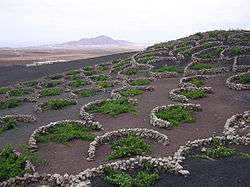Lanzarote
| Native name: <span class="nickname" ">Lanzarote Nickname: Lanza | |
|---|---|
|
Flag of Lanzarote | |
 | |
| Geography | |
| Location | Atlantic Ocean |
| Coordinates | 29°02′06″N 13°37′59″W / 29.035°N 13.633°WCoordinates: 29°02′06″N 13°37′59″W / 29.035°N 13.633°W |
| Archipelago | Canary Islands |
| Total islands | 7 |
| Major islands | Tenerife, Fuerteventura, Gran Canaria |
| Area | 845.9 km2 (326.6 sq mi) |
| Highest elevation | 671 m (2,201 ft) |
| Highest point | Peñas del Chache, Famara |
| Administration | |
|
Spain | |
| Autonomous Community | Canary Islands |
| Province | Las Palmas |
| Largest settlement | Arrecife (pop. 55,203) |
| Demographics | |
| Population | 142,132 (2011) |
| Pop. density | 227,6 /km2 (5,895 /sq mi) |
| Ethnic groups | Spanish, other minority groups |
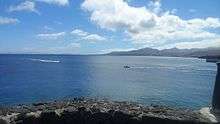
Lanzarote (/ˌlænzəˈrɒti/; Spanish pronunciation: [lanθaˈɾote, lansaˈɾote]) is a Spanish island, the easternmost of the autonomous Canary Islands in the Atlantic Ocean, approximately 125 km (78 mi) off the coast of Africa and 1,000 km (621 mi) from the Iberian Peninsula. Covering 845.94 square kilometers (327 sq mi), it is the fourth largest of the islands in the archipelago. With 141,938 inhabitants, Lanzarote is the third most populous island of the Canary Islands, after Tenerife and Gran Canaria. In the center-west of the island is the Timanfaya National Park, which is one of the main attractions of Lanzarote. Its capital is Arrecife.
The first recorded name for the island, given by Angelino Dulcert, was Insula de Lanzarotus Marocelus, after the Genovese navigator Lancelotto Malocello, from which the modern name is derived. The island's name in the native language was Tyterogaka or Tytheroygaka, which may mean "one that is all ochre" (referring to the island's predominant colour).[1]
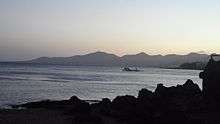
Geography
Lanzarote is located 11 km (7 mi) north-east of Fuerteventura and just over 1 km (0.62 mi) from Graciosa. The dimensions of the island are 60 km (37 mi) from north to south and 25 km (16 mi) from west to east. Lanzarote has 213 km (132 mi) of coastline, of which 10 km (6 mi) are sand, 16.5 km (10 mi) are beach, and the remainder is rocky. Its landscape includes the mountain ranges of Famara (671 meters (2,201 ft))[2] in the north and Ajaches (608 m) to the south. South of the Famara massif is the El Jable desert which separates Famara and Montañas del Fuego. The highest peak is Peñas del Chache rising to 670 meters (2,198 ft) above sea level. The "Tunnel of Atlantis," the largest underwater volcanic tunnel in the world, is part of the Cueva de los Verdes lava tube.
Climate
Often called' Islands of Eternal Spring' Lanzarote[3] is one of the Canary Islands in which has a subtropical-desert climate according to the Köppen climatic classification.[4] The small amount of precipitation is mainly concentrated in the winter. Rainfall during summer is a rare phenomenon (there has never been any recorded rainfall in July) and several summers are completely dry without any precipitation. On average the Island receives approximately 16 days of precipitation between December and February.[3] Sometimes, the hot sirroco wind prevails causing dry and dusty conditions across the island.[3] Average precipitation in June and August is less than 0.5 mm (0.020 in). It closely borders on a tropical climate, with winter means of 18 °C (64 °F) and summer means of 25 °C (77 °F).
| Climate data for Lanzarote Airport (1981-2010) | |||||||||||||
|---|---|---|---|---|---|---|---|---|---|---|---|---|---|
| Month | Jan | Feb | Mar | Apr | May | Jun | Jul | Aug | Sep | Oct | Nov | Dec | Year |
| Record high °C (°F) | 27.9 (82.2) |
29.0 (84.2) |
32.7 (90.9) |
36.3 (97.3) |
42.6 (108.7) |
40.7 (105.3) |
42.9 (109.2) |
43.6 (110.5) |
40.5 (104.9) |
37.1 (98.8) |
34.2 (93.6) |
27.5 (81.5) |
43.6 (110.5) |
| Average high °C (°F) | 20.7 (69.3) |
21.3 (70.3) |
22.9 (73.2) |
23.5 (74.3) |
24.6 (76.3) |
26.3 (79.3) |
28.2 (82.8) |
29.1 (84.4) |
28.6 (83.5) |
26.7 (80.1) |
24.2 (75.6) |
21.8 (71.2) |
24.8 (76.6) |
| Daily mean °C (°F) | 17.4 (63.3) |
17.9 (64.2) |
19.0 (66.2) |
19.6 (67.3) |
20.8 (69.4) |
22.6 (72.7) |
24.3 (75.7) |
25.2 (77.4) |
24.7 (76.5) |
23.0 (73.4) |
20.7 (69.3) |
18.6 (65.5) |
21.1 (70) |
| Average low °C (°F) | 14.0 (57.2) |
14.3 (57.7) |
15.0 (59) |
15.7 (60.3) |
16.8 (62.2) |
18.8 (65.8) |
20.4 (68.7) |
21.2 (70.2) |
20.8 (69.4) |
19.4 (66.9) |
17.2 (63) |
15.4 (59.7) |
17.4 (63.3) |
| Record low °C (°F) | 8.0 (46.4) |
9.0 (48.2) |
8.3 (46.9) |
9.5 (49.1) |
11.5 (52.7) |
12.4 (54.3) |
15.4 (59.7) |
16.6 (61.9) |
15.5 (59.9) |
12.0 (53.6) |
10.9 (51.6) |
9.0 (48.2) |
8.0 (46.4) |
| Average rainfall mm (inches) | 16.5 (0.65) |
18.2 (0.717) |
12.5 (0.492) |
5.2 (0.205) |
1.5 (0.059) |
0.1 (0.004) |
0.0 (0) |
0.5 (0.02) |
2.2 (0.087) |
9.9 (0.39) |
14.7 (0.579) |
29.3 (1.154) |
110.6 (4.357) |
| Average rainy days (≥ 1.0 mm) | 3 | 3 | 2 | 1 | 0 | 0 | 0 | 0 | 0 | 2 | 3 | 4 | 18 |
| Average relative humidity (%) | 68 | 68 | 66 | 66 | 66 | 66 | 68 | 68 | 70 | 71 | 69 | 71 | 68 |
| Mean monthly sunshine hours | 203 | 201 | 241 | 255 | 297 | 292 | 308 | 295 | 248 | 235 | 207 | 196 | 2,978 |
| Source: Agencia Estatal de Meteorología[5] | |||||||||||||
Geology
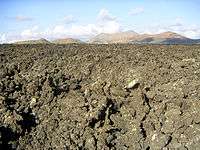
Lanzarote is the easternmost island of the Canary Islands and has a volcanic origin. It was born through fiery eruptions and has solidified lava streams as well as extravagant rock formations. The island emerged about 15 million years ago as product of the Canary hotspot. The island, along with others, emerged after the break-up of the African and the American continental plates. The greatest recorded eruptions occurred between 1730 and 1736 in the area now designated Timanfaya National Park.
Demographics
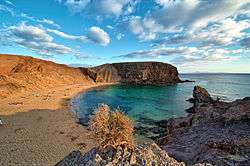
As of 2010, 139,000 people live on Lanzarote[6] which is an increase of 9.4% from 2006 (127,000).[7] The seat of the island government (Cabildo Insular) is in the capital, Arrecife, which has a population of 59,000.[6] The majority of the inhabitants (73.9%) are Spanish, with a sizable number of residents from other European nations, mainly British (4.0%), Germans (2.6%) and Irish (2.5%).[8] Other populous groups include immigrants from Colombia, Morocco, Ecuador, Western Africa, China and India, which constitute a large proportion of the remaining 15.6% of the population.
| Nationality | Population | % of Lanzarote's Population |
|---|---|---|
| Spanish | 99,998 | 73.9% |
| Colombian | 5,703 | 4.2% |
| British | 5,420 | 4.0% |
| Moroccan | 3,606 | 2.7% |
| German | 3,450 | 2.6% |
| Irish | 3,378 | 2.5% |
| Ecuadorians | 1,950 | 1.4% |
| Other nationalities | 11,758 | 8.7% |
The island has an international airport, Arrecife Airport, through which 5,438,178 passengers travelled in 2008.[9] Tourism has been the mainstay of the island's economy for the past 40 years, the only other industry being agriculture.
Lanzarote is part of the province of Las Palmas, and is divided into seven municipalities:
- Arrecife
- Haría
- San Bartolomé
- Teguise (includes Isla de La Graciosa and four smaller islets, including Alegranza)
- Tías
- Tinajo
- Yaiza
Biodiversity
Plants
There are five hundred different kinds of plants on the island of which 17 species are endemic. These plants have adapted to the relative scarcity of water in the same way as succulents. They include the Canary Island date palm (Phoenix canariensis), which is found in damper areas of the north, the Canary Island pine (Pinus canariensis), ferns, and wild olive trees (Olea europaea). Laurisilva trees which once covered the highest parts of Risco de Famara are rarely found today. After winter rainfall, the vegetation comes to a colourful bloom between February and March.
The vineyards of La Gería, Lanzarote DO wine region, are a protected area. Single vines are planted in pits 4–5 m wide and 2–3 m deep, with small stone walls around each pit. This agricultural technique is designed to harvest rainfall and overnight dew and to protect the plants from the winds.
Fungi
There are 180 different species of lichen-forming fungi. These survive in the suitable areas like rock surfaces, and promote weathering.
Animals
Apart from bats and other mammals which accompanied humans to the island (including the dromedary which was used for agriculture and is now a tourist attraction), there are few vertebrate species on Lanzarote. These include birds (such as falcons), and reptiles. Some interesting endemic animals are the Gallotia lizards, and the blind Munidopsis polymorpha crabs found in the Jameos del Agua lagoon, which was formed by a volcanic eruption. The island is also home to one of two surviving populations of the threatened Canarian Egyptian vulture.
Natural symbols
The official symbols from nature associated with Lanzarote are Munidopsis polymorpha (Blind crab) and Euphorbia balsamifera (Tabaiba dulce).[10]
History
Lanzarote is estimated the first Canary Island to be settled. The Phoenicians may have settled there around 1100 BC, though no material evidence survives. The Greek writers and philosophers Herodotus, Plato and Plutarch described the garden of the Hesperides, a mythic orchard at the far West of the world, which some like to identify with the Canaries.
The first known record came from Pliny the Elder in the encyclopedia Naturalis Historia on an expedition to the Canary Islands.[11] The names of the islands (then called Insulae Fortunatae, the "Fortunate Isles") were recorded as Junonia (Fuerteventura), Canaria (Gran Canaria), Ninguaria (Tenerife), Junonia Major (La Palma), Pluvialia(El Hierro) and Capraria (La Gomera). Lanzarote and Fuerteventura, the two easternmost Canary Islands, were only mentioned as the archipelago of the "purple islands". The Roman poet Lucan and the Greek astronomer and geographer Ptolemy gave their precise locations.[12] After the fall of the Western Roman Empire, the Canary islands were ignored until 999 when the Arabs arrived at the island which they dubbed al-Djezir al-Khalida and other names.
In 1336, a ship arrived from Lisbon under the guidance of Lanzarote da Framqua, alias Lancelotto Malocello. A fort was later built in the area of Montaña de Guanapay near today's Teguise. Castilian slaving expeditions in 1385 and 1393 seized hundreds of Guanches and sold them in Spain, initiating the slave trade in the islands.[13]
Jean de Béthencourt arrived in 1402, heading a private expedition under Castilian auspices. Bethencourt first visited the south of Lanzarote at Playas de Papagayo, and within a matter of months the French overran the island, which lacked mountains and gorges to serve as retreats for the small remaining population of Guanches, so many of whom were taken away as slaves, it was said that only 300 men remained.
At the southern end of the municipality of Yaiza, in the area known as "El Rubicón", the first European settlement in the Canary Islands in 1402, where the conquest of the Archipelago began he was installed.[14] In this place the Cathedral of Saint Martial of Limoges. This cathedral was destroyed by English pirates in the sixteenth century and is currently in Femés, the Hermitage of Saint Martial of Limoges dedicated to this saint. This diocese was moved in 1483 to Las Palmas de Gran Canaria (Roman Catholic Diocese of Canarias).[14]
In 1404, the Castilians with the support of the King of Castile came and fought the local Guanches, who were further decimated. The islands of Fuerteventura and El Hierro were later similarly conquered. In 1477 a decision by the royal council of Castile confirmed a grant of Lanzarote and Fuerteventura, with the smaller islands of Ferro and Gomera to the Castilian nobles Herrera, who held their fief until the end of the 18th century.[15]
In 1585, the Ottoman admiral Murat Reis temporarily seized Lanzarote. In the 17th century, pirates raided the island and took 1,000 inhabitants to slavery in Cueva de los Verdes.
From 1730 to 1736 (for 2,053 days), the island was hit by a series of volcanic eruptions, producing 32 new volcanoes in a stretch of 18 km (11 mi). The minister of Yaiza, Don Andrés Lorenzo Curbelo documented the eruption in detail until 1731. Lava covered a quarter of the island's surface, including the most fertile soil and eleven villages. One hundred smaller volcanoes were located in the area called Montañas del Fuego, the "Mountains of Fire".
In 1768, drought affected the deforested island, and winter rains did not fall. Much of the population was forced to emigrate to Cuba and the Americas, including a group which formed a significant addition to the Spanish settlers in Texas at San Antonio de Bexar in 1731. Another volcanic eruption occurred within the range of Tiagua in 1824 which was less violent than the major eruption between 1730 and 1736.
In 1927, Lanzarote, along with Fuerteventura, became part of the province of Las Palmas.
Several archeological expeditions have uncovered the prehistoric settlement at the archaeologic site of El Bebedero in Teguise (village).[16] In one of those expeditions, by a team from the Universidad de Las Palmas de Gran Canaria and a team from the Universidad de Zaragoza, yielded about 100 Roman potsherds, nine pieces of metal, and one piece of glass. The artifacts were found in strata dated between the first and 4th centuries. The finds show that Romans did trade with the Canaries, though there is no evidence of settlements.[12]
Biosphere Reserve controversy
The island has a UNESCO Biosphere Reserve protected site status. According to a report in the Financial Times, this status was endangered by a local corruption scandal. Since May 2009, police have arrested the former president of Lanzarote, the former mayor of Arrecife and more than 20 politicians and businessmen in connection with illegal building permits along Lanzarote's coastline. UNESCO has threatened to revoke Lanzarote's Biosphere Reserve status, "(i)f the developments are not respecting local needs and are impacting on the environment".[17][18]
The President of the Cabildo of Lanzarote denied "any threat to Lanzarote's UNESCO status".[19]
Notables
Famous people who were born or have lived on the island are Rosana Arbelo, a singer; César Manrique, an artist; José Saramago, a Portuguese Nobel Prize for Literature winner who died there; Princess Alexia of Greece and Denmark and husband, Carlos Morales Quintana; Jean Arriete Prud'homme (Surname later Hispanicized to Perdomo), a French nobleman who arrived with Jean de Béthencourt and gave his name to the village of Arrieta.
Festivals
The most established festival on the island is held each year on September 15th in the village of Mancha Blanca in the municipality of Tinajo in honor of Our Lady of Sorrows (Virgen de los Dolores), also called Virgin of the Volcanoes (the Patron Saint of Lanzarote). In this pilgrimage people from all over the island, mostly dressed in traditional costumes, participate.
In culture and art
Film
- One Million Years B.C. (1966)
- Even Dwarfs Started Small (1970) – shot entirely in Lanzarote
- Road to Salina (1970)
- The Martian Chronicles (1980) – TV mini-series
- Krull (1983)
- Doctor Who: "Planet of Fire" (1984)
- Enemy Mine (1985)
- Stranded: Náufragos (2002)
- Broken Embraces (2009)
- Doctor Who: "Kill the Moon" (2014)
- In the Heart of the Sea (2015)
Music videos
- Stone Roses singles "Fools Gold" and "I Wanna be Adored".
- Textures (band) - "Reaching Home".
- Marina and the Diamonds - "I'm a Ruin" [20]
Literature
- The Wind Off the Small Isles (1968)
- Lanzarote by Michel Houellebecq (2000)
- The Possibility of an Island by Michel Houellebecq (2005)
- The Lanzarote Story by Allen Maslen
- Island Zero by Nick Cracknell (2016)
Gallery

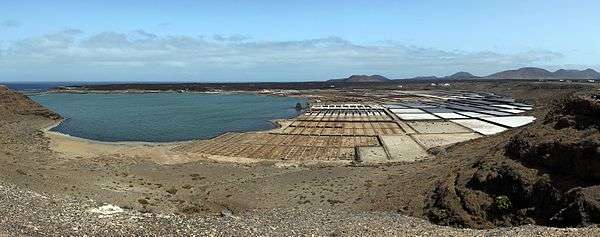
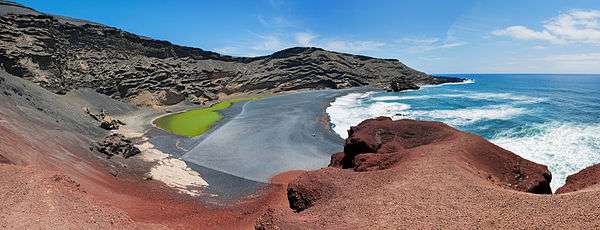
References
- ↑ "Diccionario Ínsuloamaziq-Tyterogaka".
- ↑ Photo: Famara Official Tourism Office of the Canaries
- 1 2 3 none, none (2001-2016). "SpainLanzarote". SpainLanzarote. SpainLanzarote. Retrieved 30/11/16. Check date values in:
|access-date=(help) - ↑
- ↑ "Guía resumida del clima en España (1981-2010)".
- 1 2 "Datos de Lanzarote - Población de derecho de Lanzarote según municipio". Retrieved 2009-11-24.
- ↑ "Datos de Lanzarote — Población de derecho de Lanzarote según municipio". Retrieved 2007-11-08.
- ↑ "Informe sobre la Población de Lanzarote — Marzo 2006" (pdf). Retrieved 2009-11-24.
- ↑ "Tráfico de pasajeros, operaciones y carga en los aeropuertos españoles 2008" (pdf). Retrieved 2009-11-24.
- ↑ Ley 7/1991, de 30 de abril, de símbolos de la naturaleza para las Islas Canarias
- ↑ "Pliny the Elder, The Natural History, BOOK VI. AN ACCOUNT OF COUNTRIES, NATIONS, SEAS, TOWNS, HAVENS, MOUNTAINS, RIVERS, DISTANCES, AND PEOPLES WHO NOW EXIST, OR FORMERLY EXISTED., CHAP. 37. (32.)—THE FORTUNATE ISLANDS.". www.perseus.tufts.edu. Retrieved 2016-11-18.
- 1 2 "Roman Trade with the Canary Islands". Retrieved 2009-11-24.
- ↑ Alfred W. Crosby, Ecological Imperialism: the biological expansion of Europe 900-1900 (Cambridge) 1986:87, citing John Mercer, The Canary Islands, Their Prehistory, Conquest and Survival 1980:148-59.
- 1 2 San Marcial del Rubicón y los Obispados de Canarias
- ↑ Henry Kamen, Empire: how Spain became a world power, 1492-1763 2002:11.
- ↑ Atoche Peña, Pablo. "EXCAVACIONES on the Canary islands". www.personales.ulpgc.es. Retrieved 2016-11-18.
- ↑ Barr, Caelainn; Mulligan, Mark (July 5, 2010). "Lanzarote faces losing its eco status". Financial Times. London, Madrid. Retrieved 12 November 2010.
- ↑ Building craze threatens to end Lanzarote's biosphere status The Independent. 7 July 2010
- ↑ Greenslade, Roy (2010-07-08). "Canary Islands protests at Financial Times investigation". Greenslade Blog. London: The Guardian. Retrieved 12 November 2010.
- ↑ Diamandis, Marina (30 January 2015). "Marina and the Diamonds: 'I killed Electra Heart with sleeping pills'". The Guardian. Retrieved 30 January 2015.
Further reading
- Joachim Pott, Joachim Hüppe/de la Torre, Wofredo Wildpret Die Kanarischen Inseln. Natur- und Kulturlandschaften = The Canary Islands. Natural and Cultural Landscapes, Ulmer : Stuttgart 2003, 320 S., 295 color photos, 28 colored graphica, 3 tables. (represented and illustrated by Geobotanik). ISBN 3-8001-3284-2.
- Wilkens, Horst: Lanzarote — Blind Crabs, Hoopoes and Volcanoes. A Guide to the Countryside, Plants and Animals of an Exceptional Volcanic Island. NATURALANZA Ulrike Strecker 2009, 120 pages, with colour photos. ISBN 978-3-942999-03-8.
- Strecker, Ulrike & Wilkens, Horst: Lanzarote — Life on Lava. Book of Illustrations of the most impressive landscapes, animals and plants. 120 pages, more than 90 colour photos, hardcover. ISBN 3-942999-02-1.
External links
| Wikimedia Commons has media related to Lanzarote. |
- Official tourism site of Lanzarote
- Lanzarote at DMOZ
 Lanzarote travel guide from Wikivoyage
Lanzarote travel guide from Wikivoyage

